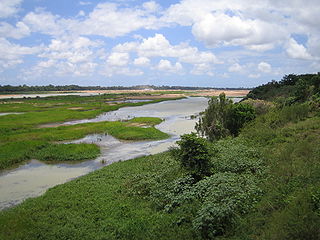Massa is a Chadic language spoken in southern Chad and northern Cameroon by the Masa people. It has approximately 200,000 speakers.

The Lower Burdekin languages were probably three distinct Australian Aboriginal languages spoken around the mouth of the Burdekin River in north Queensland. One short wordlist in each was collected in the 19th century, and published in the second volume of The Australian Race in 1886. These languages have since gone extinct, with no more having been recorded. Due to the paucity of the available data, we know almost nothing of their grammatical structure.

The North Cape York Paman languages are a subdivision of the Paman languages consisting of forty languages, all spoken on the Cape York Peninsula of Queensland, Australia. The languages are grouped largely according to R. M. W. Dixon. The only extant branches of this family are Umpila and the Wik languages.
Urradhi is a Paman language of the Cape York Peninsula of Queensland, Australia, and is apparently extinct. It was spoken by the Urradhi people. Urradhi proper is the south-western dialect of the language. The name is composed of urra "this" and the proprietive dhi "having". The south-eastern dialect of the same language, Wudhadhi, is made of the same elements, wudha being "this". These are part of a group of closely related and highly mutually intelligible dialects, these being Angkamuthi to the north of Urradhi, Atampaya inland from these, Utudhanamu inland north from Atampaya, Yantaykenu further north, being the language of the Bamaga area, Yadhaykenu on the east coast north of Wudhadhi, and Yaraytyana further north again. This group has no common language name, though Urradhi is commonly used as a cover name. It is unknown when it became extinct.
Wik-Ngatharr, or Wik-Alken (Wik-Elken), is a Paman language spoken on the Cape York Peninsula of Queensland, Australia, by the Wik-Ngatharr people. It is a co-dialect with Wik-Ngathan, and more distantly related to the other Wik languages. In 1981 there were 86 speakers.
Wik-Mungkan, or Wik-Mungknh, is a Paman language spoken on the northern part of Cape York Peninsula of Queensland, Australia, by around 1,650 Wik-Mungkan people, and related peoples including the Wikalkan, Wik-Ngathana, Wikngenchera language groups. Wik Mungkan is healthier than most other languages on the peninsula, and is developing and absorbing other Aboriginal languages very quickly.
Kugu-Muminh (Wik-Muminh), also known as Kugu- or Wik-Nganhcara (Wikngenchera), is a Paman language spoken on the Cape York Peninsula of Queensland, Australia, by several of the Wik peoples. There are multiple dialects, only two of which are still spoken: Kugu-Muminh itself, and Kugu-Uwanh.
Sikiana, or Kashuyana is a Carib language that was spoken by 33 people in Brazil and 15 people in Suriname. It was spoken in Venezuela at one time and is now probably extinct there. The Warikyana dialect became extinct around 2000, and the language frequently goes by the name of the surviving dialect, Sikiana.
The Roglai language is a Chamic language of southern Vietnam. There are four dialects :
- Northern
- Du Long
- Southern
- Cac Gia
Ding is a Bantu language that is spoken in the Democratic Republic of Congo.
Barawana (Baré) is an Arawakan language of Venezuela and Brazil, where it is nearly extinct. It was spoken by the Baré people. Aikhenvald (1999) reports "just a few old speakers left" of Baré proper, and that the Guinau variety was extinct. Kaufman (1994) considers Baré proper, Guinau, and extinct Marawá to be distinct languages; Aikhenvald, dialects of a single languages.
Ayizo (Ayizɔ) is a Gbe language of Benin. It is a dialect cluster of Ayizo proper, Kotafon, and Gbesi.
Bembe (Kibeembe) is a Bantu language of Congo-Brazzaville. It is closely related to Kikongo. Pangwa may be a dialect.
Kayan is a dialect cluster spoken by the Kayan people of Borneo. It is a cluster of closely related dialects with limited mutual intelligibility, and is itself part of the Kayan-Murik group of Austronesian languages.
Kulisusu is an Austronesian language of Southeast Sulawesi, Indonesia. It is part of a dialect chain with two minor languages, Koroni and Taloki.

Durubalic is a small family of extinct Australian Aboriginal languages of Queensland.
Wik-Me'nh is a Paman language of the Cape York Peninsula of Queensland, Australia
Kimaragang (Marigang), Tobilung, and Rungus are varieties of a single Austronesian language of Sabah, Malaysia. The three varieties share moderate mutual intelligibility. Children are not learning it well in some areas.
Taupota is an Oceanic language of the Milne Bay Province, Papua New Guinea. It appears to be a dialect chain, with southern varieties called Wa'ema and western Wedau.
Tagin (Tagen), also known as West Dafla, and Bangni, is a Sino-Tibetan language spoken in India.



